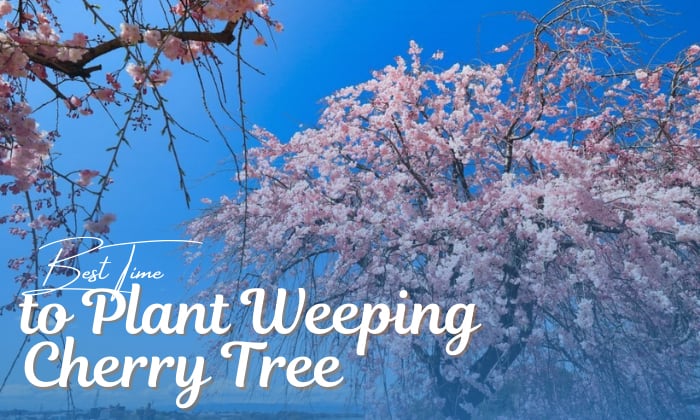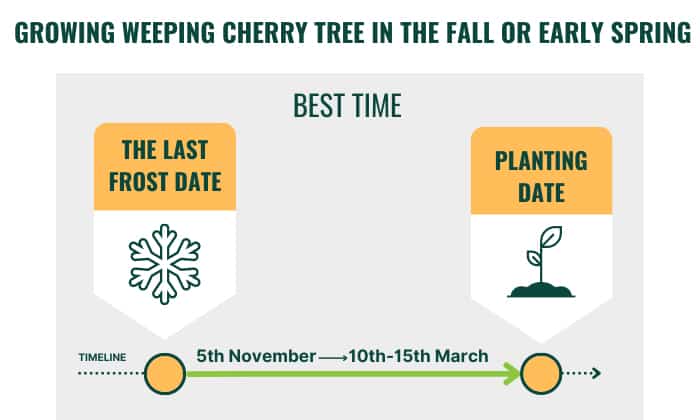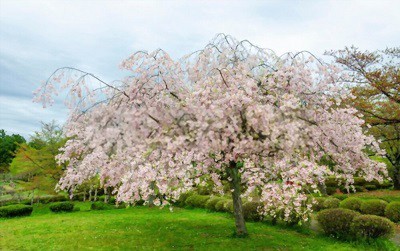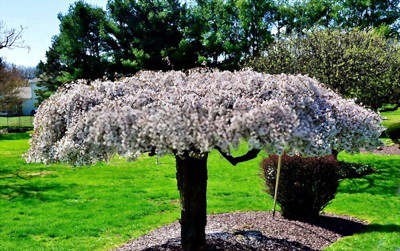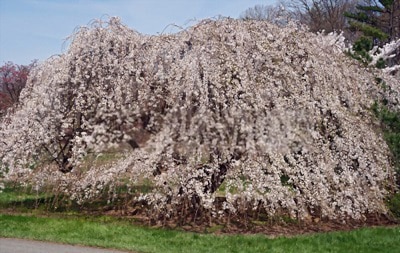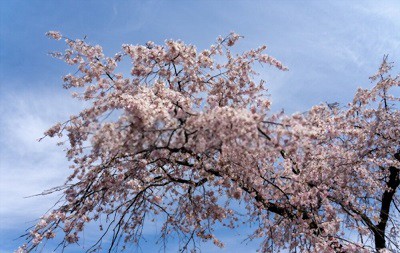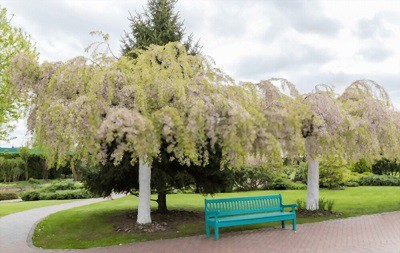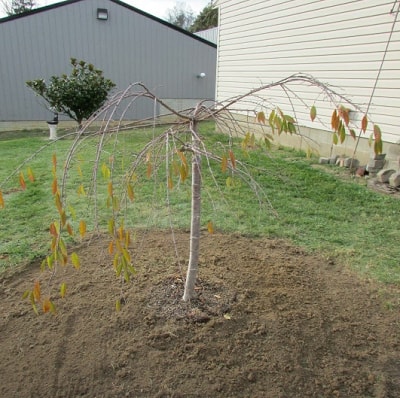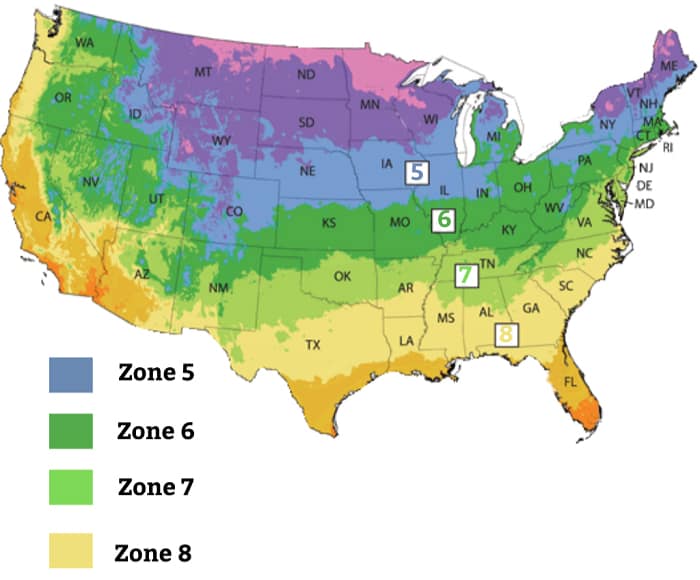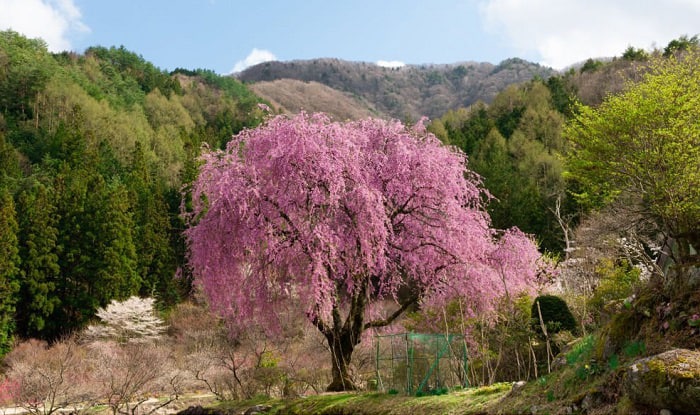There is a variety of weeping Japanese cherry tree cultivars to choose from. After you’ve selected the right one for you—whether it’s full-sized or dwarf-sized—the next thing to do is plan when to plant it.
So, when to plant weeping cherry tree? Do so in the fall or early spring, from 5th November until 10th to 15th March, once the last frost in your area has passed.
If you want to know more about weeping cherry trees, when and how to plant them, tips for caring, and other relevant information, simply read further.
Table of Contents
Best Time to Plant Weeping Cherry Tree
The recommended time for planting a weeping cherry tree is in the fall or early spring seasons, once the dangers of frost have passed. In fact, you can plant these trees throughout 5th November until 10th to 15th March.
Since the weeping cherry is tolerant to heat and drought, you can also grow a weeping cherry tree in the summer (June to September) in states like Michigan, which have intense summers, as long as they are planted in favorable soil conditions.
Additionally, it is also hardy to temperatures as low as -10°F, meaning it can grow in winter (December to March). However, it may experience problems in growing due to lack of sunlight.
It’s recommended to plant weeping cherry trees in USDA Hardiness Zones 5 to 8, such as Arizona, West Virginia, Georgia, Ohio, and more. Refer to the hardiness zone map to find out your state’s via https://planthardiness.ars.usda.gov/
Different Types of Weeping Cherry Trees
1. Weeping Higan Cherry Tree
This species features small but showy pale pink flowers, slender whip-like branches, and glossy medium to dark green leaves. It is commonly used as a specimen tree in landscapes, borders, foundations, and as entranceway ornamental trees.
Botanical Name: Prunus pendula
Height: Up to 30 feet
Known Cultivars:
- Prunus pendula ‘Pendula Rosea’. This variety blooms white to pink flowers in late winter to early spring and produces round-shaped, pea-sized inedible fruits. Its weeping form is pronounced, making it an ideal specimen plant.
- Double Weeping Cherry Tree. Compared to other varieties, this cultivar produces paler pink, double flowers that last a week longer. As its flowers lose their bloom, its leaves form a fresh-looking canopy during the summer.
2. Dwarf Weeping Cherry Tree
True to its name, this ornamental tree is characterized by its small size and quick growth rate. It also produces a cluster of aromatic flowers in the spring but lacks fruit. This weeping cherry variety is an ideal choice for smaller yards and lawns.
Botanical Name: Prunus subhirtella
Height: Up to 8 feet
Known Cultivars:
- Snow Fountain Weeping Cherry Tree. Its name refers to how the tree’s cascading branches reach the ground in the early spring, resembling a white fountain as it’s covered with white flowers.
- Prunus x subhirtella ‘Pendula Rubra’. This similarly compact cultivar is characterized by its cluster of carmine-pink flowers that grow on cascading branches.
3. Hiromi Dwarf Weeping Cherry Tree
This is the smallest of all dwarf weeping cherry trees. In fact, it’s even considered to have shrub-like growth. This slender cultivar is able to produce dainty pink blooms every spring, making it a perfect addition for small gardens.
Botanical Name: Prunus jacquemontii ‘Hiromi’
Height: Up to 6 feet
4. Yoshino Cherry ‘Shidare-Yoshino’
This tree is a cultivar of the ornamental hybrid, which is a hybrid between the Prunus subhirtella ‘Rosea’ and Prunus speciosa produced in the late 1800s. In the early spring, this cultivar produces clusters of brilliantly white flowers.
Botanical Name: Prunus x yedoensis ‘Shidare-Yoshino’
Height: Up to 30 feet
5. Yoshino Cherry ‘Somei-Yoshino’
Known for its slightly almond-scented and pale pink to white flowers, this cultivar is able to bloom early in the spring and lasts for about 2 to 3 weeks.
Botanical Name: Prunus x yedoensis ‘Somei-Yoshino’
Height: Up to 30 feet
How to Plant Weeping Cherry Tree
You can grow weeping cherry trees from seed but this is rarely done since they are easily transplanted from their bare roots or containers when they are initially grown indoors.
- To plant, acquire a weeping cherry tree root ball then dig a hole wide and deep enough to accommodate the spread of its mature roots.
- Insert the root ball inside the hole, with the top portion buried in line with the soil.
- Firmly pat the area to tuck the plant in, then water the base of the tree thoroughly. Mulch the soil using chipped bark or compost to encourage moisture uptake.
- Afterward, stake the tree outside of its root ball using a wooden or metal stake at a 45-degree angle, then properly tie them together.
Caring Tips for Weeping Cherry Tree
1. Location
It is essential to know where to plant weeping cherry trees as they may not grow well in other regions.
As such, these trees grow best in USDA Hardiness Zones 5 to 8, specifically in areas where they can receive at least 6 hours of direct sunlight daily.
Additionally, they can tolerate some shade, which may result in reduced blooms during spring.
2. Soil
They are adaptable to a wide variety of soils, even those that have poor conditions. However, if you want to achieve the tall and large weeping cherry tree size you desire, make sure you plant them in loose, well-draining soils.
3. Water
Watering is the key for maintaining weeping cherry trees. Although they don’t require a lot, they should still be watered about once or twice a week. This should be decreased to once every 2 or 3 weeks during the winter season or periods of cold temperatures.
4. Fertilizer
Use a slow-release, low-nitrogen-content fertilizer once annually in the early spring as new leaves and buds appear so that they stay healthy throughout the season.
5. Pruning
Pruning is not necessarily required, but it does make your trees look clean. Remove any dying, dead or diseased branches as well as any old or faded flowers during the winter so that new ones can grow in spring.
Frequently Asked Questions
How fast do weeping cherry trees grow?
Their size (both height and spread) increases by 1 to 2 feet per year. This rate is similar to most types of trees.
When do weeping cherry trees bloom?
The bloom time for weeping cherry trees is in the spring season. It will last for several weeks, usually 2 to 3 weeks, depending on the cultivar.
What are the disadvantages of weeping cherry trees?
They may experience a number of problems if they don’t get enough water and sunlight. This includes bacterial and fungal infections such as leaf spots, twig cankers, powdery mildew, mold, and rots.
Insects and pests, such as tent caterpillars, scales, aphids, borers, Japanese beetles, and spider mites, may also emerge, especially in the early summer season.
To prevent these, you must ensure that your tree receives sufficient moisture in its soil and prune diseased, dead, or dying parts of the tree. Insecticides and antimicrobials are encouraged if the infestation is severe.
What is the lifespan of a weeping cherry tree?
If a weeping cherry tree is well taken care of, it is able to live around 30 to 40 years. This is why they are preferable to planting flowering cherry trees, which significantly have a shorter life expectancy of 15 to 20 years.
What can I plant next to weeping cherry trees?
Since weeping cherries are deciduous trees, colorful evergreen shrubs, and groundcovers will complement them well. This includes plants such as periwinkle, lavender, marigolds, and even Japanese forest grass.
What climate is best for weeping cherry trees?
Weeping cherry trees grow best in USDA Zones 5 to 8, where they can receive full sunlight for at least 6 hours, and temperatures reach -10°F.
Conclusion
Knowing when to plant weeping cherry tree is essential since they may encounter problems in growing if they are planted after spring or summer. However, it doesn’t just stop there as you should also know how to plant and care for a weeping cherry tree.
Choosing the planting site and making sure it has the proper soil conditions as well as watering, fertilizing, and pruning, are just as important, so better keep all the information mentioned above in mind!
Read more:

Hi, I am William – Floridayards’ digital content creator. My job is to find answers to all your concerns with thorough research and our team’s expert advice. I will also bring you honest reviews on the best products and equipment for raising your beautiful garden. Please look forward to our work!


